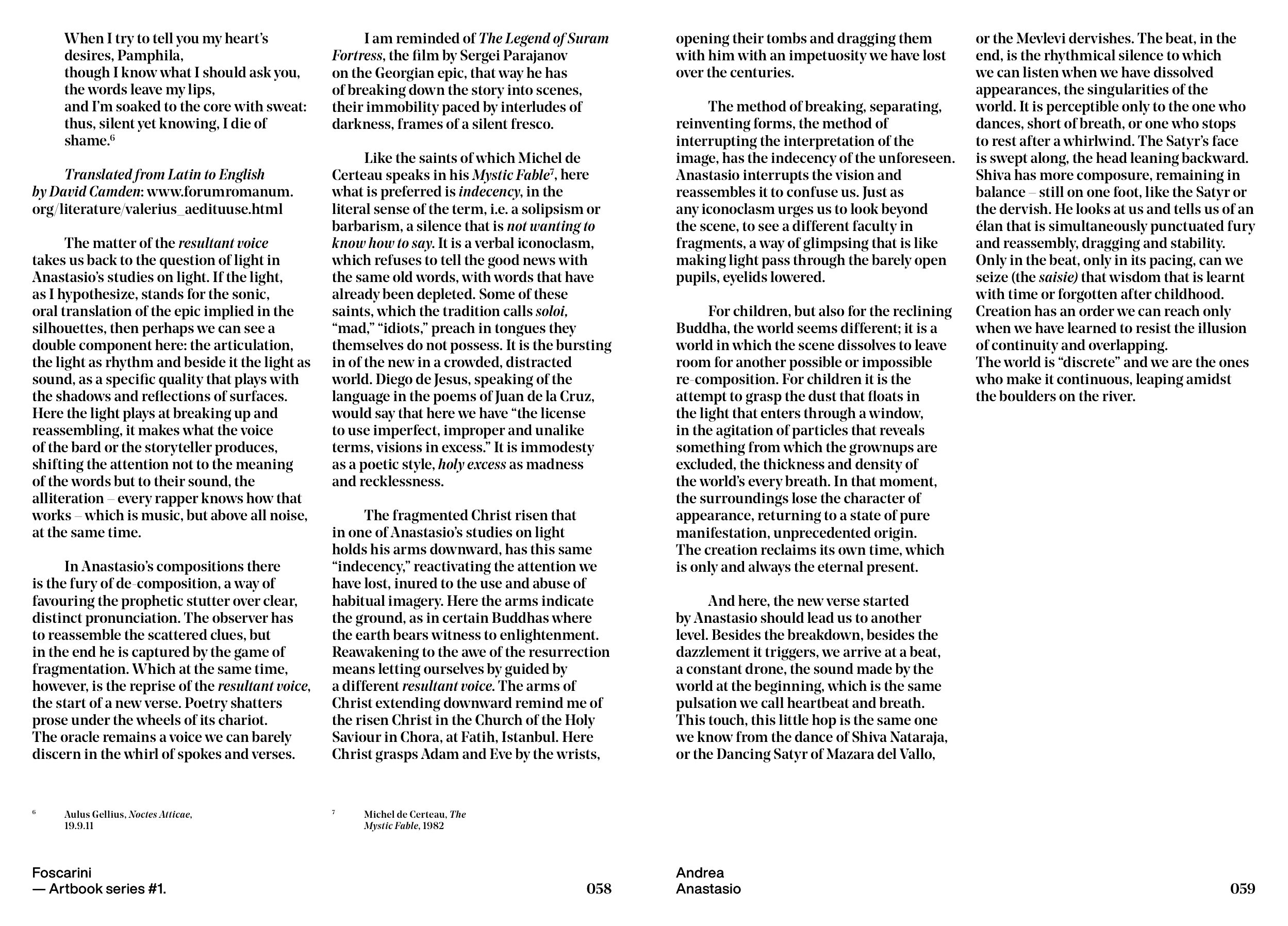Foscarini
— Artbook series #1.
Andrea
Anastasio
058
059
Foscarini
— Artbook series #1.
Andrea
Anastasio
058
059
When I try to tell you my heart’s
desires, Pamphila,
though I know what I should ask you,
the words leave my lips,
and I’m soaked to the core with sweat:
thus, silent yet knowing, I die of
shame.6
Translated from Latin to English
by David Camden: www.forumromanum.
org/literature/valerius_aedituuse.html
The matter of the resultant voice
takes us back to the question of light in
Anastasio’s studies on light. If the light,
as I hypothesize, stands for the sonic,
oral translation of the epic implied in the
silhouettes, then perhaps we can see a
double component here: the articulation,
the light as rhythm and beside it the light as
sound, as a specific quality that plays with
the shadows and reflections of surfaces.
Here the light plays at breaking up and
reassembling, it makes what the voice
of the bard or the storyteller produces,
shifting the attention not to the meaning
of the words but to their sound, the
alliteration – every rapper knows how that
works – which is music, but above all noise,
at the same time.
In Anastasio’s compositions there
is the fury of de-composition, a way of
favouring the prophetic stutter over clear,
distinct pronunciation. The observer has
to reassemble the scattered clues, but
in the end he is captured by the game of
fragmentation. Which at the same time,
however, is the reprise of the resultant voice,
the start of a new verse. Poetry shatters
prose under the wheels of its chariot.
The oracle remains a voice we can barely
discern in the whirl of spokes and verses.
opening their tombs and dragging them
with him with an impetuosity we have lost
over the centuries.
The method of breaking, separating,
reinventing forms, the method of
interrupting the interpretation of the
image, has the indecency of the unforeseen.
Anastasio interrupts the vision and
reassembles it to confuse us. Just as
any iconoclasm urges us to look beyond
the scene, to see a different faculty in
fragments, a way of glimpsing that is like
making light pass through the barely open
pupils, eyelids lowered.
For children, but also for the reclining
Buddha, the world seems different; it is a
world in which the scene dissolves to leave
room for another possible or impossible
re-composition. For children it is the
attempt to grasp the dust that floats in
the light that enters through a window,
in the agitation of particles that reveals
something from which the grownups are
excluded, the thickness and density of
the world’s every breath. In that moment,
the surroundings lose the character of
appearance, returning to a state of pure
manifestation, unprecedented origin.
The creation reclaims its own time, which
is only and always the eternal present.
And here, the new verse started
by Anastasio should lead us to another
level. Besides the breakdown, besides the
dazzlement it triggers, we arrive at a beat,
a constant drone, the sound made by the
world at the beginning, which is the same
pulsation we call heartbeat and breath.
This touch, this little hop is the same one
we know from the dance of Shiva Nataraja,
or the Dancing Satyr of Mazara del Vallo,
I am reminded of The Legend of Suram
Fortress, the film by Sergei Parajanov
on the Georgian epic, that way he has
of breaking down the story into scenes,
their immobility paced by interludes of
darkness, frames of a silent fresco.
Like the saints of which Michel de
Certeau speaks in his Mystic Fable7, here
what is preferred is indecency, in the
literal sense of the term, i.e. a solipsism or
barbarism, a silence that is not wanting to
know how to say. It is a verbal iconoclasm,
which refuses to tell the good news with
the same old words, with words that have
already been depleted. Some of these
saints, which the tradition calls soloi,
“mad,” “idiots,” preach in tongues they
themselves do not possess. It is the bursting
in of the new in a crowded, distracted
world. Diego de Jesus, speaking of the
language in the poems of Juan de la Cruz,
would say that here we have “the license
to use imperfect, improper and unalike
terms, visions in excess.” It is immodesty
as a poetic style, holy excess as madness
and recklessness.
The fragmented Christ risen that
in one of Anastasio’s studies on light
holds his arms downward, has this same
“indecency,” reactivating the attention we
have lost, inured to the use and abuse of
habitual imagery. Here the arms indicate
the ground, as in certain Buddhas where
the earth bears witness to enlightenment.
Reawakening to the awe of the resurrection
means letting ourselves by guided by
a different resultant voice. The arms of
Christ extending downward remind me of
the risen Christ in the Church of the Holy
Saviour in Chora, at Fatih, Istanbul. Here
Christ grasps Adam and Eve by the wrists,
or the Mevlevi dervishes. The beat, in the
end, is the rhythmical silence to which
we can listen when we have dissolved
appearances, the singularities of the
world. It is perceptible only to the one who
dances, short of breath, or one who stops
to rest after a whirlwind. The Satyr’s face
is swept along, the head leaning backward.
Shiva has more composure, remaining in
balance – still on one foot, like the Satyr or
the dervish. He looks at us and tells us of an
élan that is simultaneously punctuated fury
and reassembly, dragging and stability.
Only in the beat, only in its pacing, can we
seize (the saisie) that wisdom that is learnt
with time or forgotten after childhood.
Creation has an order we can reach only
when we have learned to resist the illusion
of continuity and overlapping.
The world is “discrete” and we are the ones
who make it continuous, leaping amidst
the boulders on the river.
6
Aulus Gellius, Noctes Atticae,
19.9.11
7
Michel de Certeau, The
Mystic Fable, 1982







